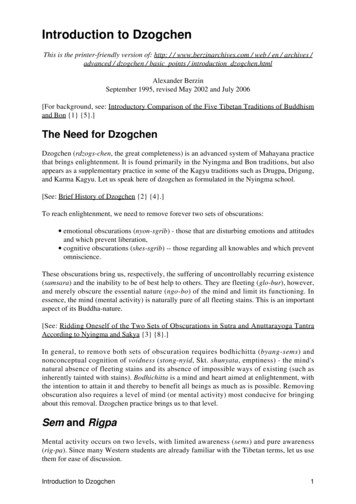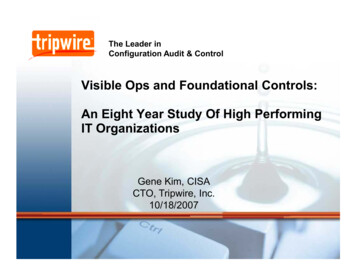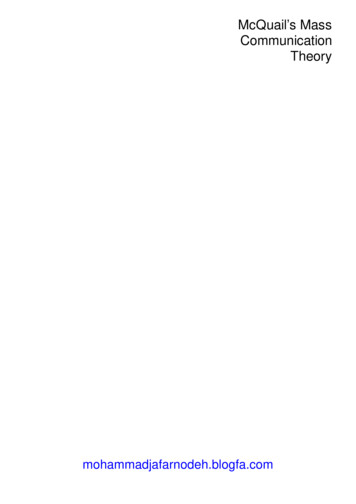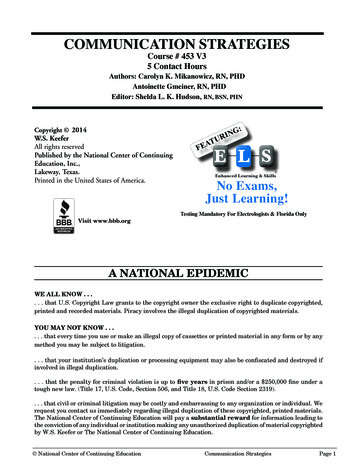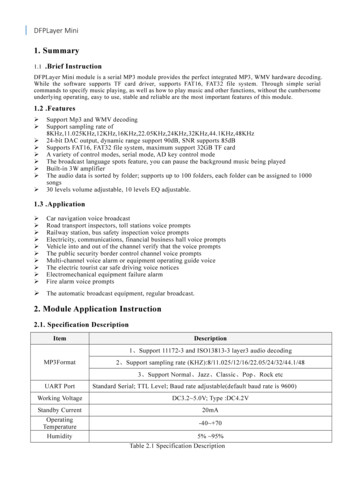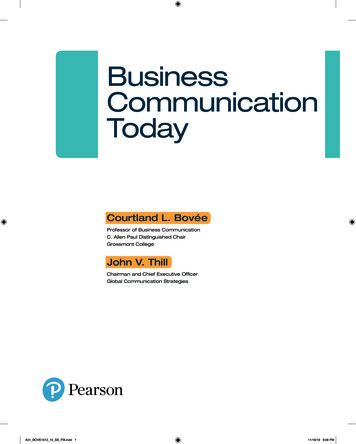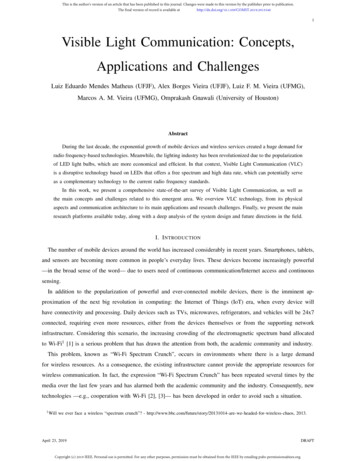
Transcription
This is the author's version of an article that has been published in this journal. Changes were made to this version by the publisher prior to publication.The final version of record is available ible Light Communication: Concepts,Applications and ChallengesLuiz Eduardo Mendes Matheus (UFJF), Alex Borges Vieira (UFJF), Luiz F. M. Vieira (UFMG),Marcos A. M. Vieira (UFMG), Omprakash Gnawali (University of Houston)AbstractDuring the last decade, the exponential growth of mobile devices and wireless services created a huge demand forradio frequency-based technologies. Meanwhile, the lighting industry has been revolutionized due to the popularizationof LED light bulbs, which are more economical and efficient. In that context, Visible Light Communication (VLC)is a disruptive technology based on LEDs that offers a free spectrum and high data rate, which can potentially serveas a complementary technology to the current radio frequency standards.In this work, we present a comprehensive state-of-the-art survey of Visible Light Communication, as well asthe main concepts and challenges related to this emergent area. We overview VLC technology, from its physicalaspects and communication architecture to its main applications and research challenges. Finally, we present the mainresearch platforms available today, along with a deep analysis of the system design and future directions in the field.I. I NTRODUCTIONThe number of mobile devices around the world has increased considerably in recent years. Smartphones, tablets,and sensors are becoming more common in people’s everyday lives. These devices become increasingly powerful—in the broad sense of the word— due to users need of continuous communication/Internet access and continuoussensing.In addition to the popularization of powerful and ever-connected mobile devices, there is the imminent approximation of the next big revolution in computing: the Internet of Things (IoT) era, when every device willhave connectivity and processing. Daily devices such as TVs, microwaves, refrigerators, and vehicles will be 24x7connected, requiring even more resources, either from the devices themselves or from the supporting networkinfrastructure. Considering this scenario, the increasing crowding of the electromagnetic spectrum band allocatedto Wi-Fi1 [1] is a serious problem that has drawn the attention from both, the academic community and industry.This problem, known as “Wi-Fi Spectrum Crunch”, occurs in environments where there is a large demandfor wireless resources. As a consequence, the existing infrastructure cannot provide the appropriate resources forwireless communication. In fact, the expression “Wi-Fi Spectrum Crunch” has been repeated several times by themedia over the last few years and has alarmed both the academic community and the industry. Consequently, newtechnologies —e.g., cooperation with Wi-Fi [2], [3]— has been developed in order to avoid such a situation.1 Willwe ever face a wireless “spectrum crunch”? - aded-for-wireless-chaos, 2013.April 23, 2019DRAFTCopyright (c) 2019 IEEE. Personal use is permitted. For any other purposes, permission must be obtained from the IEEE by emailing pubs-permissions@ieee.org.
This is the author's version of an article that has been published in this journal. Changes were made to this version by the publisher prior to publication.The final version of record is available ng the new technologies to solve the problem of Wi-Fi spectrum crunch, Visible Light Communication(VLC) [4], [5] presents great potential. In fact, the interest in such form of wireless optical communication hasgrown, especially given the possibility of cooperation with radio frequency systems [6]. Another factor that attractsresearchers to this new research field is the possibility of working with frequencies much higher than those usedin WiFi devices. The use of these frequencies allows wireless communications at very high speeds (theoretically inthe order of terabytes/s).In addition to that, new light-emitting technologies, such as LEDs, become more popular and accessible, enablingnew perspectives for optical wireless communication [7], [8]. Finally, the increasing interest and exploration of thevisible light spectrum have brought a number of innovations that are already present in the market, such as Li-Fitechnology [9], presented in 2011 and already marketed by companies specializing in VLC.In this work, we present a comprehensive survey of Visible Light Communication. In order to accomplish that,we analyze the main concepts and challenges related to this promising area. This includes the recent applications ofVisible Light Communication in emerging areas and discussion of the open questions that may foster new research.We also point to future directions considering recent work found in the literature. To summarize, we provide thefollowing contributions related to the VLC area: We explore the fundamentals of the light spectrum and provide a discussion regarding the adoption of thatpart of the electromagnetic spectrum to provide communication; We provide a comprehensive insight into how VLC became popular throughout the last 10 years, giving themain reasons behind the growing popularity of that technology. We give an overview of Visible Light Communication and its architecture, including transmitters, receiversand standardization efforts throughout the last decade. We also provide a detailed explanation of modulationschemes and multiple access techniques adopted in the literature. We delve into application and challenges of the area. We offer a detailed analysis of the main research platforms developed in the literature. We give a perspective of the future of Visible Light Communication in the wireless technology field.Despite the novelty of VLC and the emergence of new research in the field, we already observe a numberof surveys about VLC in the past couple of years, from a broader perspective to specific areas. In [10], theauthors present an initial review on LED-based communication, while highlighting the main benefits of this typeof communication. Following the popularization of Solid State Lighting (SSL), authors in [11] offer a review onVLC while focusing on challenges and channel modeling. In addition, authors also offer a comprehensive review ofthe IEEE 802.15.7 [12], which was relatively new at that time. The integration of illumination and communicationhas been studied carefully in [13]. The authors adopt the idea of Smart Lighting and Mobile Optical WirelessNetworks (LightNets) and focus their survey on the integration of VLC in the mobile communication field. Theidea of using VLC as a complementary technology to radiofrequency was further explored in [14], where authorsexplore the possibility of using Visible Light Communication as part of the 5G wireless communication system.The main focus of this work is to compare VLC with RF-based communication and offer a review on mobile andApril 23, 2019DRAFTCopyright (c) 2019 IEEE. Personal use is permitted. For any other purposes, permission must be obtained from the IEEE by emailing pubs-permissions@ieee.org.
This is the author's version of an article that has been published in this journal. Changes were made to this version by the publisher prior to publication.The final version of record is available ed VLC researches. In [15] and [16], a comprehensive review of LED-based VLC is offered. Both works adopta broader review perspective, passing through several aspects of the area, and authors in [15] also target indoorapplications challenges. In [17], authors discuss the benefits that VLC systems may offer to the current issues inwireless communication networks. In [18], authors explore the state-of-the-art on multi-user VLC systems, exploringnew concepts in literature such as NOMA-VLC, also explored in this survey. Al et al. follow the same path byexploring multi-user VLC techniques in [19] In [20], a system’s perspective overview is given by the authors, withtwo main focuses: uplink strategies and challenges in the co-existence with RF technologies. Also, some platformsare analyzed by the authors (OpenVLC and SmartVLC). This survey differs significantly because we focus on thehardware and software characteristics of all current research platforms in VLC field. In sum, Table I summarizesthe existing surveys of VLC and highlights the topics each survey address.The present work takes a horizontal approach, in which we cover the main aspects of Visible Light Communicationby offering a comprehensive discussion of the main features responsible for the popularization of VLC-basedapplications, such as LEDs, along with their main drawbacks and future directions. Moreover, we take an approachto Visible Light Communication from a broader perspective, offering a deep survey of the main novelties in the areaconsidering the context of the actual Internet. Finally, we offer a deep study over the research platforms developedfor VLC studies, covering hardware and software designs, main contributions to the scientific area and evaluationwithin the future paradigm of the Internet of Light.Content exploredHistory perspectiveClassification of typesComparison to VLCChannel ModellingLED theoryLEDLED typesProperties as photosensorsIntegration with the InternetTransmitters propertiesCommunication ArchitectureReceiver propertiesStandardizationChannel characteristicsPhysical LayerModulation schemesOrthogonal Multiple AccessMultiple AccessNon-Orthogonal Multiple AccessMIMOIndoor CommunicationVehicular CommunicationApplicationsUnderwater engesNoise and interferenceMobilityUplinkSoftware OverviewResearch PlatformsHardware OverviewMulti-hopPerspective of VLC in the futureMarket and commercializationEnergy Harvesting in VLCPathak et al. [21]Karunatilaka et al. [15]XKumar et al. [10]XXXXXXXXXXXXXXXXXXXMedina et al. [16]XSaadi et al. [11]Wu et al. [14]XXXXSevincer et al. [13]XKhan et al. [17]ObeedAlRehmanXOptical XXXXXXXXXXXXXXXXXXXXXXXThis XXXXXXXXXXXXXXXXXXXXTable I: Surveys on Visible Light CommunicationThe remainder of this paper is organized as follows: initially, we offer a fundamental introduction to the areaalong with a brief background and motivation. Then, in Section II, we overview Visible Light Communication. InSection III, we present components of a VLC system. In Section IV, we discuss technical details of modulationmethods and MAC layer protocols. Section V introduces a series of applications found in the literature whereVLC is used, and section VI presents the main challenges surrounding the area nowadays. We analyze all researchplatforms designed to study VLC in Section VII. In Section VIII, we give a future perspective to VLC consideringthe advancements in the area. Finally, in Section IX, we present the final discussions, as well as a broader perspectiveof the area.April 23, 2019DRAFTCopyright (c) 2019 IEEE. Personal use is permitted. For any other purposes, permission must be obtained from the IEEE by emailing pubs-permissions@ieee.org.
This is the author's version of an article that has been published in this journal. Changes were made to this version by the publisher prior to publication.The final version of record is available athttp://dx.doi.org/10.1109/COMST.2019.29133484A. What is VLC?Visible Light Communication is the name given to the type of communication in which data is sent through themodulation of light waves from the visible spectrum, ranging from 380 nm to 750 nm wavelengths. In general, anysystem in which information can be transmitted using some kind of light visible to human eyes can be named asVisible Light Communication. However, the idea of this type of communication is to transfer data in an imperceptibleway to human vision, so that what is seen is only the regular environment illumination, without any noticeablechange. There are several other nomenclatures created over the years for similar technologies, such as OWC (OpticalWireless Communication) and Li-Fi(Light Fidelity), for example, which will be discussed in Section II.Note that radio waves have been studied by various works since the beginning of the nineteenth century [22].This has led to a number of discoveries about the properties of this type of wave, bringing several new technologiesto the daily lives of people around the world, from military resources to medical applications. The efficiency ofradio communications has improved greatly due to advances in research. Although, visible light as a form ofcommunication medium has attracted the attention from academic institutions and industry only over the pastdecade [23], it is still underexplored when compared to the radio frequency spectrum of the electromagneticspectrum.Figure 1: Electromagnetic Spectrum [21].Figure 1 shows the range of the electromagnetic spectrum from low frequencies, where radio waves are located,to higher frequencies where the gamma radiation is located. As we previously pointed, the visible spectrum of lightranges from 380 nm to 750 nm. Any information that is transferred by modulating the light waves in this rangecan be considered a type of Visible Light Communication. It is important to observe that the radio waves, whichincludes the Wi-Fi technology, covers frequencies ranging from 3 KHz to 300 GHz. On the other hand, visiblelight frequencies vary from 430 THz to 770 THz, which is 10,000 times larger than the entire radiofrequencyspectrum [3].It is worth noting that Visible Light Communication is a very promising technology once the implementationof VLC systems is closely linked to the rapid and increasing adoption of LEDs around the world, as well as theimminent approximation of the smart lighting paradigm [13]. Presumably, the industry has reacted positively tothese novelties in lighting technologies. For example, Philips HUE2 is a LED light bulb that can be controlled by2 Yourpersonal Wireless lighting system -www2.meethue.com/en-us/about-hue/, 2017.April 23, 2019DRAFTCopyright (c) 2019 IEEE. Personal use is permitted. For any other purposes, permission must be obtained from the IEEE by emailing pubs-permissions@ieee.org.
This is the author's version of an article that has been published in this journal. Changes were made to this version by the publisher prior to publication.The final version of record is available athttp://dx.doi.org/10.1109/COMST.2019.29133485the Smartphone, creating ambiances for specific purposes, such as work or study. In this way, it is likely that, inthe future, LED light bulbs will play two different roles: lighting and communication.B. A Brief History of VLCDespite the recent interest in VLC, studies involving light-based communications systems can be found over thepast centuries. Light has always been among the elements used by humans to communicate with each other. Sincethe earliest times, the use of light as a means of communication was already seen in many cultures around the world,whether in the use of smoke signals or torches, for example. In this sense, a great example of a functional VisibleLight Communication system was registered centuries ago, in Ancient Greece. Historian Polybius developed acommunication system in which torches were used in order to exchange information. This was done by establishingan agreement between emitter and receiver, and the alphabet was represented by a set of 5 torches [24].By the end of the eighteenth century, in Napoleonic France, engineer Charles Chappe invented the opticaltelegraph [25]. This mechanism consisted of two lateral bars, called indicators, attached to a long bar, called theregulator. Through the rotation of the lateral stems, it was possible to create a series of different symbols. Opticaltelegraphs were placed in towers, at a distance of 10 to 15 kilometers. Using this structure and efficient coding, itwas possible to create up to 98 different combinations, which could be seen from miles away. In a few decades,France was already equipped with hundreds of telegraphs, forming a large communication network, which servedFrench interests for more than 50 years and was later replaced by the electric telegraph system.Later, by the end of the nineteenth century, Alexander Graham Bell and his assistant Charles Tainter establishedcommunication at a distance of 213 meters using the Photophone [26]. This device, created by Graham Bell itself,was formed by a transmitter and a receiver, as can be seen in Figure 2. Briefly, the system worked as follows: thesunlight was reflected in a mirror, reaching a thin surface of a glass, which vibrated according to the person’s voice.Thereafter, the light was transported through a second lens to the receiver, where a parabolic mirror reflected thelight in a selenium cell, whose resistance varied according to the intensity of light received. Despite the popularityof the telephone, another device patented by Graham Bell, the scientist has always considered the photophone hisgreatest invention.Figure 2: The photophone, created by Alexander Graham Bell [26].April 23, 2019DRAFTCopyright (c) 2019 IEEE. Personal use is permitted. For any other purposes, permission must be obtained from the IEEE by emailing pubs-permissions@ieee.org.
This is the author's version of an article that has been published in this journal. Changes were made to this version by the publisher prior to publication.The final version of record is available ure 3: Light spectrum research themes in the past decade.Communication through optical media only gained attention in the 1970’s. On that period, studies demonstratedthe potential of wireless optical communication (in this case, infrared) in an internal environment where it waspossible to explore bands of the Electromagnetic spectrum on a scale of THz- [27]. Such systems were able toreach up to 1 Mbps. More recently, in the late 1990’s, infrared systems were able to achieve up to 50 Mbps datarate [28].In the early of 2000’s, LED bulbs were first considered for experiments involving VLC. Tanaka et al. used awhite LED bulb for lighting and communication in an indoor environment, reaching up to 400 Mbps communicationdata rate [29]. This was the first step in a wide range of VLC works in the 21st century. After this work, otherresearchers came with great innovations, such as new modulation techniques and new technologies of LED bulbs.An important milestone in the history of Visible Light Communication was achieved in 2011, when Harald Haasmade the first demonstration of Li-Fi (Light Fidelity) during a TED Talk3 . This presentation has become verypopular, reaching millions of views in a few months. Clearly, the academic community reacted to the novelty and,as a consequence, the amount of research in the area increased considerably, as it can be seen in Figure 3. Notable,the number of works with the keyword “Visible Light Communication” on the IEEE Xplore platform over the yearsincreases exponentially.Currently, VLC is extensively studied. Major names from industry and academy, such as NASA [30], [31],Disney [32] and Philips4 have products and research in the field.C. MotivationThe interest in technologies involving VLC has increased considerably in recent years. For example, actionsfrom the international standard body and major corporations [12] show the increasing interest in this form of3 Wireless4 Perfectdata from every light bulb -Https://www.ted.com/talks/harald haas wireless data from every light bulb, 2017.light, precise location - s/led-based-indoor-positioning.html, 2016.April 23, 2019DRAFTCopyright (c) 2019 IEEE. Personal use is permitted. For any other purposes, permission must be obtained from the IEEE by emailing pubs-permissions@ieee.org.
This is the author's version of an article that has been published in this journal. Changes were made to this version by the publisher prior to publication.The final version of record is available munication.Moreover, the exponential increase in the number of mobile devices around the world has become a majorincentive for the study of VLC as a complement to Wi-Fi [33] technologies, especially in indoor environments wherelight can be controlled and there is less interference from external factors. Since most people tend to stay most ofthe time indoors, the implementation of VLC technologies would be simpler, using a preexisting infrastructure.While there has been an effort in the study of VLC in the last decades, one of the factors that limited researchreasonably was the technology used in commercial light bulbs, mostly incandescent or fluorescent, which didnot allow precise and high-speed control of illumination. The popularization of LED bulbs in the last decadeoffered a new opportunity for research. Currently, several devices use LEDs in addition to conventional light bulbs.TV displays, smartphones, and automobiles are among devices equipped with LEDs. With the advancement oftechnology and popularization of LED prices, much of the research has focused on the use of these types of a lightsource as transmitters, and even as receivers [9], [32], [34], as it will be discussed further on Section II.The possibility of higher data rates provided by the frequencies, in the order of THz, is another great motivationfor studies in the area. Currently, Wi-Fi technologies are struggling to reach speeds in the order of Gbps. The802.11n Wi-Fi standard, for example, can reach up to 150 Mbps5 . It is important to observe that many upcomingWi-Fi standards will bring further improvements in throughput, which can lead to a future where Wi-Fi speeds areup to 6 Gbps [35]. Systems using Optical Wireless Communication have already achieved rates of up to 42.8 Gbps6 .Visible light spectrum brings a number of opportunities for studies involving VLC. In contrast to the radiofrequency, the visible light spectrum is not licensed, therefore devices can transmit at any frequency [36]. Whereasin the spectrum of radio waves the frequency varies from KHz to GHz, in the visible spectrum the frequency is inthe order of THz, that is, 1, 000 times greater. Furthermore, unlike infrared and ultraviolet, which may be harmfulto human health, visible light spectrum presents no danger. Finally, radio waves can traverse obstacles like walls,so that a conventional wireless network can be intercepted by intruders at any time. In VLC systems, typically whatyou see is what is transmitted. In other words, due to the properties of light, an indoor VLC system becomes muchsafer [37].In general, the current VLC scenario is very rich and broad, with opportunities in the most diverse areas, fromapplications such as LightId7 to the exploration of different modulation methods considering particular propertiesof light [38].II. V ISIBLE L IGHT C OMMUNICATION OVERVIEWThis section provides an overview of Visible Light Communication. Initially, we will discuss the main technologiesthat relate to VLC in some way, among them Light Fidelity (Li-Fi), Optical Wireless Communication and FreeSpace Optical Communication. It is important to highlight the similarities and differences between these types of5 Examiningthe Adoption Rate of Gigabit Wi-Fi - -adoption-rate-of-gigabit-wifi/, 2017.6 Wi-fion rays of light ter-and-never-overloaded/#top, 2017.7 LightID Technology - gy-design/technology/lightid.html, 2016.April 23, 2019DRAFTCopyright (c) 2019 IEEE. Personal use is permitted. For any other purposes, permission must be obtained from the IEEE by emailing pubs-permissions@ieee.org.
This is the author's version of an article that has been published in this journal. Changes were made to this version by the publisher prior to publication.The final version of record is available munication. After that, we will present the main works responsible for leveraging the studies in the area [21],[32], [39], [40] and boosting the interests for the commercialization of this technology in different sectors [9], [41],[42]. We also discuss the relationship of increasing interest in the area of VLC and the popularization of LEDs(Light Emitting Diodes). In this sense, the main types of LEDs will be presented, along with their importance forthe area. After this, we point out a series of advantages and disadvantages that VLC systems have when comparedto Wi-Fi systems. Finally, the main academic and commercial trends will be addressed.A. VLC and other nomenclaturesThere are a number of nomenclatures given to the different technologies involving light as a form of communication. Some of the main nomenclatures are:Optical Wireless Communications (OWC): Optical Wireless Communication involves any type of data transferin which the medium used is the optical medium. In other words, the entire spectrum of light can be used as aform of communication, be it infrared, visible or ultraviolet [43].Free-Space Optical Communication: Despite having a similar concept to OWC, this nomenclature has beenwidely used for large-scale transmissions, such as communications between satellites and towers on Earth [44].Communication in free space involves data transmission in a media without barriers, such as air, atmosphere, andspace. Applications using such nomenclature tend to be very complex, dealing with atmospheric turbulences [45],[46] and high-cost equipment [47].Visible Light Communication (VLC): The use of wireless optical communication has become very popular inrecent years. In particular, studies involving the visible light spectrum are increasingly common, since this area hasa great academic and commercial potential [33]. Visible Light Communication includes all the frequencies of thevisible light spectrum, that is, waves ranging from 430 THz to 790 THz [21].Light Fidelity (Li-Fi): The term Li-Fi was coined in 2011 during a TED Talk, as discussed earlier, whereProfessor Harald Haas gave a practical demonstration of the potential of the technology. One can say that LiFi is a type of VLC [9]. However, the creator of the term published a paper in 2015, highlighting the maindifferences between VLC and Li-Fi [48]. Among the differences between the two technologies, two-way multi-usercommunication and high speed, aspects present in the concept of Li-Fi, can be highlighted.B. LEDs: a great opportunity for VLCSeveral factors contributed to the growing interest in VLC. Among all, what stands out most is the use of LED formanipulation of light waves. Due to its characteristics such as price, LED light bulbs have become the main mediumused for Visible Light Communication. In addition, LED light bulbs became increasingly popular, integrating variousenvironments where it would be advantageous to use light as a form of communication. Therefore, it is commonto choose this type of light bulb in VLC [15] systems.The LED (Light Emitting Diode) is a device which uses electroluminescence and semiconductors in orderto generate light. More specifically, LEDs are made of materials that are partly capable of conducting current.Additionally, light is emitted when the electric current passes through the material, a phenomenon known asApril 23, 2019DRAFTCopyright (c) 2019 IEEE. Personal use is permitted. For any other purposes, permission must be obtained from the IEEE by emailing pubs-permissions@ieee.org.
This is the author's version of an article that has been published in this journal. Changes were made to this version by the publisher prior to publication.The final version of record is available iconductor MaterialGaAs - Gallium ArsenideGaAsP - Gallium Arsenic PhosphideGaAsP - Gallium Arsenic PhosphideGaP - Gallium PhosphideInGaAIP - Indium Gallium Aluminum PhosphideSiC - Silicon CarbideGaN - Gallium llowGreenBlueWhiteTable II: LEDs and colorselectroluminescence. This happens due to the existence of electron holes (when an atom lacks electrons) betweentwo semiconductors. Therefore, when electrons flow through it, they fill the electron holes, and consequently,they emit photons. The light is emitted in the visible spectrum, which varies from low to high-frequency waves,corresponding to a specific color. Red LEDs, for example, are commonly made of gallium arsenide phosphide(GaAsP), and their wavelength varies from 630 nm to 660 nm. Table II presents some colors and its respectivesemiconductor material, as well as the wavelength of the emitted light.There are many reasons behind the exponential growth of LEDs bulbs nowadays. Some well-known advantagesof this type of light source are energy efficiency, durability, and low-cost. Residential LEDs use at least 75% lessenergy and can last 25 times longer than a traditional incandescent light bulb. In addition, it is possible to focusthe light of an LED bulb in a single direction. Due to these advantages, LEDs bulbs are used in various devices,such as smartphones, vehicles, video screens, signs, and are present in many applications, including Visible LightCommunication. The use of this technology has brought many benefits to the industry, and the future of residentiallighting is firmly based on LED lights.Figure 4: Comparison between the spectrum emission of yellow-phospho
of LED light bulbs, which are more economical and efficient. In that context, Visible Light Communication (VLC) is a disruptive technology based on LEDs that offers a free spectrum and high data rate, which can potentially serve as a complemen



